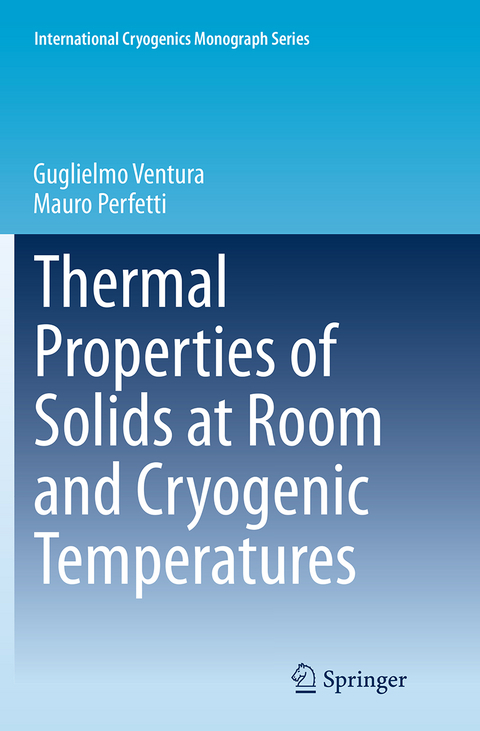
Thermal Properties of Solids at Room and Cryogenic Temperatures
Springer (Verlag)
978-94-017-7779-7 (ISBN)
Hence the properties of materials must be accurately known also at cryogenic temperatures.This book provides a guide for engineers, physicists, chemists, technicians who wish to approach the field of low-temperature material properties.
The minimum temperature in the natural universe is 2.7 K. Laboratory refrigerators can reach temperatures in the microkelvin range. Modern industrial refrigerators cool foods at 200 K, whereas space mission payloads must be capable of working at temperatures as low as 20 K. Superconducting magnets used for NMR work at 4.2 K.
Hence the properties of materials must be accurately known also at cryogenic temperatures.
This book provides a guide for engineers, physicists, chemists, technicians who wish to approach the field of low-temperature material properties. The focus is on the thermal properties and a large spectrum of experimental cases is reported. The book presents updated tables of low-temperature data on materials and a thorough bibliography supplements any further research.
Key Features include:
° Detailed technical description of experiments
° Description of the newest cryogenic apparatus
° Offers data on cryogenic properties of the latest new materials
° Current reference review
Guglielmo Ventura was professor of Cryogenics and Vacuum Technologies at the University of Florence until he retired in 2013. He is now a cryogenic consultant for INFN, Rome, in the European project LUCIFER. He has collaborated in space, rocket and balloon born experiments (measurement of the Cosmic Background Radiation or CBR) and is now involved in CUORE (Cryogenic Underground Observatory for Rare Events) underground experiments. Mauro Perfetti was born in 1988 in La Spezia (Italy). After his graduation with first class of honors in 2007, he obtained his bachelor’s degree in 2010 and his master’s degree in 2012 in Chemistry, both Summa com Laude. In 2012 he won a position as PhD student in Chemical Sciences in the University of Florence with the supervision of Professor Roberta Sessoli. Despite his young age, he is co-author of many papers published by prestigious journals. His research line, inserted in the field of Molecular Magnetism, is mainly focused on the understanding of the low temperature magnetic behaviour of anisotropic lanthanide-based Single Molecule Magnets and on the electrical and magnetic characterization of new hybrid materials composed by Single Molecule Magnets grafted on Nanoparticles.
Preface.- Dedication.- Part I.- 1 Heat Capacity.- 2 How to Measure Heat Capacity at Low Temperatures.- 3 Data of Specific Heat.- Part II.- 4 Thermal Expansion.- 5 How to Measure Thermal Expansion Coefficient at Low Temperatures.- 6 Data of Thermal Expansion.- Part III.- 7 Electrical and Thermal conductivity.- 8 How to Measure Thermal Conductivity.- 10 Data of Thermal Conductivity.
| Erscheinungsdatum | 26.08.2016 |
|---|---|
| Reihe/Serie | International Cryogenics Monograph Series |
| Zusatzinfo | 3 Illustrations, color; 101 Illustrations, black and white; XI, 216 p. 104 illus., 3 illus. in color. |
| Verlagsort | Dordrecht |
| Sprache | englisch |
| Maße | 155 x 235 mm |
| Themenwelt | Naturwissenschaften ► Chemie ► Analytische Chemie |
| Naturwissenschaften ► Chemie ► Physikalische Chemie | |
| Naturwissenschaften ► Physik / Astronomie ► Atom- / Kern- / Molekularphysik | |
| Naturwissenschaften ► Physik / Astronomie ► Festkörperphysik | |
| Technik ► Elektrotechnik / Energietechnik | |
| Technik ► Maschinenbau | |
| Schlagworte | cryogenic engineering • how to measure heat capacity at low temperatures • how to measure thermal conductivity at low temperatures • how to measure thermal expansion at low temperatures • low temperature engineering materials • materials for cryogenic applications |
| ISBN-10 | 94-017-7779-9 / 9401777799 |
| ISBN-13 | 978-94-017-7779-7 / 9789401777797 |
| Zustand | Neuware |
| Informationen gemäß Produktsicherheitsverordnung (GPSR) | |
| Haben Sie eine Frage zum Produkt? |
aus dem Bereich


